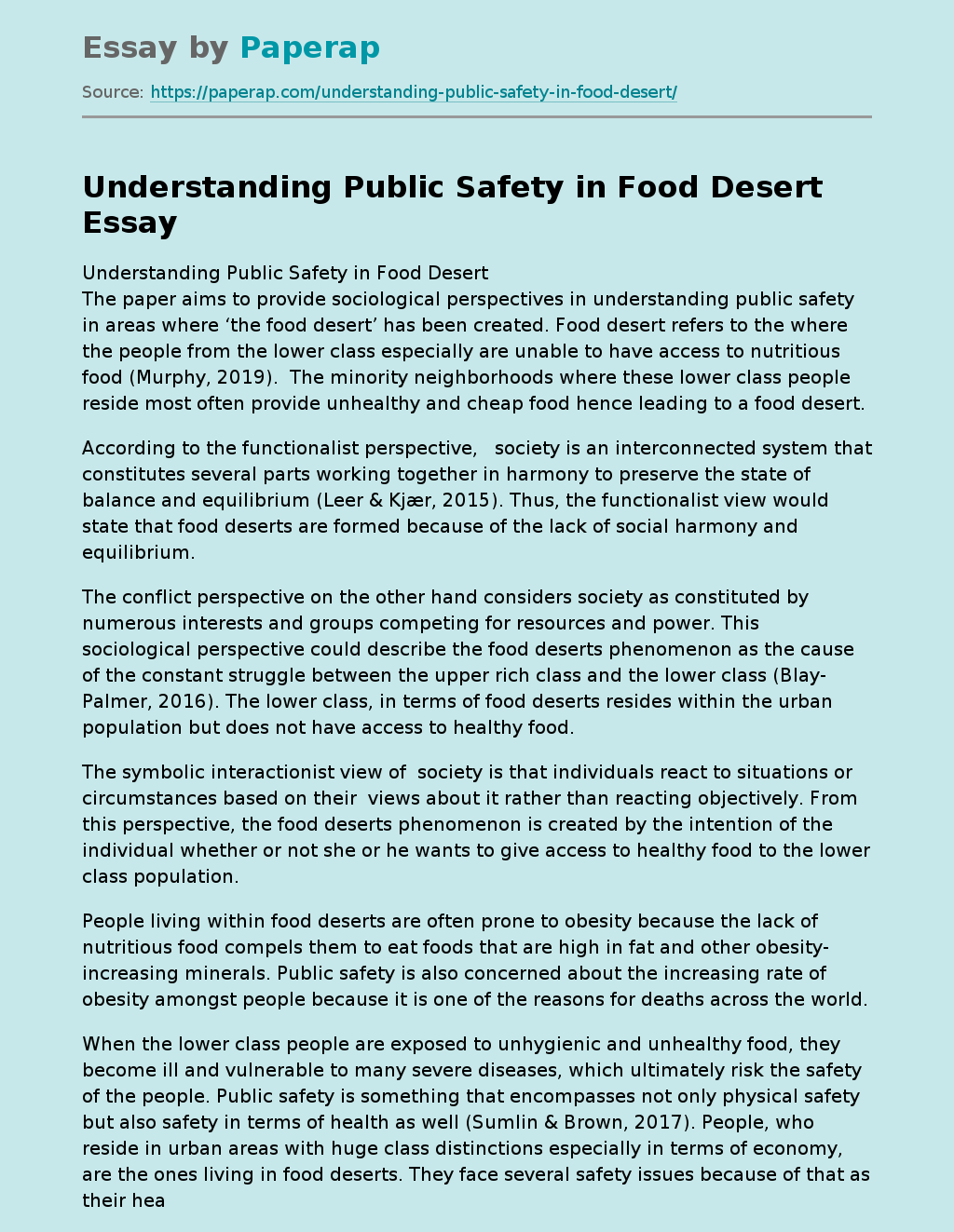Understanding Public Safety in Food Desert
Understanding Public Safety in Food Desert
The paper aims to provide sociological perspectives in understanding public safety in areas where ‘the food desert’ has been created. Food desert refers to the where the people from the lower class especially are unable to have access to nutritious food (Murphy, 2019). The minority neighborhoods where these lower class people reside most often provide unhealthy and cheap food hence leading to a food desert.
According to the functionalist perspective, society is an interconnected system that constitutes several parts working together in harmony to preserve the state of balance and equilibrium (Leer & Kjær, 2015).
Thus, the functionalist view would state that food deserts are formed because of the lack of social harmony and equilibrium.
The conflict perspective on the other hand considers society as constituted by numerous interests and groups competing for resources and power. This sociological perspective could describe the food deserts phenomenon as the cause of the constant struggle between the upper rich class and the lower class (Blay-Palmer, 2016).
The lower class, in terms of food deserts resides within the urban population but does not have access to healthy food.
The symbolic interactionist view of society is that individuals react to situations or circumstances based on their views about it rather than reacting objectively. From this perspective, the food deserts phenomenon is created by the intention of the individual whether or not she or he wants to give access to healthy food to the lower class population.
People living within food deserts are often prone to obesity because the lack of nutritious food compels them to eat foods that are high in fat and other obesity-increasing minerals.
Public safety is also concerned about the increasing rate of obesity amongst people because it is one of the reasons for deaths across the world.
When the lower class people are exposed to unhygienic and unhealthy food, they become ill and vulnerable to many severe diseases, which ultimately risk the safety of the people. Public safety is something that encompasses not only physical safety but also safety in terms of health as well (Sumlin & Brown, 2017). People, who reside in urban areas with huge class distinctions especially in terms of economy, are the ones living in food deserts. They face several safety issues because of that as their health is affected, some members of the lower class at times resort to theft or burglary to have money and access to healthy food. Public servants must realize that as long as access to healthy living is denied to the public, the rates of crime would keep increasing. When the residents of food deserts are left to die in hunger, they feel that the only way to survive is to commit a crime.
To conclude, it must be stated that the public servants have the all-important responsibility to make sure that the society stays crime-free and the first step to do that is to make the society food desert free. The essay explained the food desert phenomenon from three different sociological perspectives. Further, it also presented the association of food deserts with public safety and found that people living in food deserts often resort to crime to fulfill their basic healthy eating needs.
Works cited:
- Blay-Palmer, A. (2016). Imagining sustainable food systems. In Imagining sustainable food systems (pp. 15-28). Routledge.
- Leer, J., & Kjær, K. M. (2015). Food, Gender and Media-the Trinity of Bad Taste: A Conversation with Karen Klitgaard Povlsen. Kvinder, Køn & Forskning, (3-4).
- Murphy, B. (2019). Living in a Food Desert: How Lack of Access to Healthy Foods Can Affect Public Health – Notes From NAP. Retrieved from https://notes.nap.edu/2011/01/25/living-in-a-food-desert-how-lack-of-access-to-healthy-foods-can-affect-public-health/
- Sumlin, L. L., & Brown, S. A. (2017). Culture and food practices of African American women with type 2 diabetes. The Diabetes Educator, 43(6), 565-575.
Understanding Public Safety in Food Desert. (2021, Dec 06). Retrieved from https://paperap.com/understanding-public-safety-in-food-desert/

